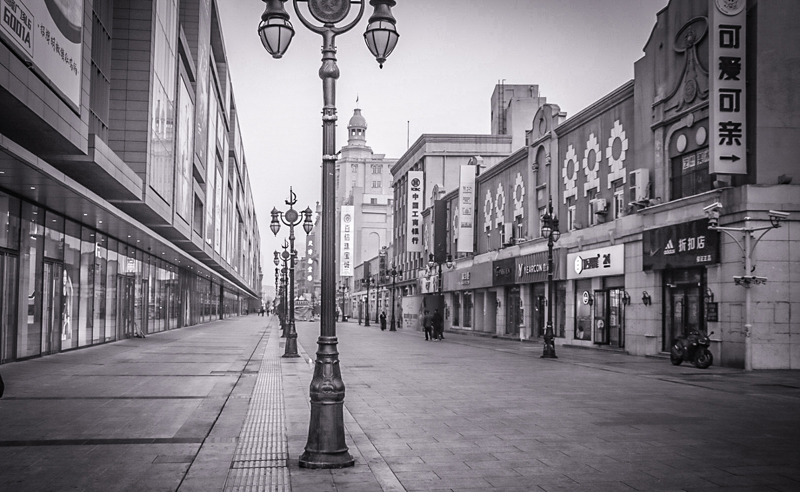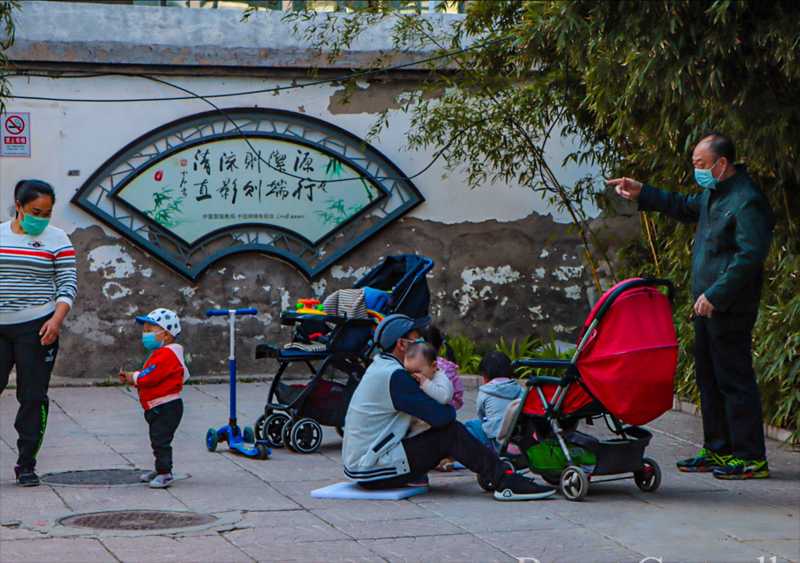
Heping Lu in Tianjin would normally be busy during Spring Festival, but in January 2020, very quiet. [Photo by Bruce Connolly/chinadaily.com.cn]
Spring 2003, preparing to return from Scotland to Beijing a little known virus, SARS (Severe Acute Respiratory Syndrome), was reportedly spreading across parts of the world, including China. On April 23, the WHO advised against travel to Beijing, putting my travels on hold! Incredibly by May 23, such advisories began to be lifted, initially for Hong Kong and Guangdong.
By June 24, Beijing was also in the clear. I was back, discovering everyone OK. Warm skies added to a feeling of peace, of calm. Long conversations ensued about how the contagion was controlled so quickly. “Testing, identifying, isolation,” were the answers. While some neighborhoods were locked down, an isolation hospital was quickly erected in suburban Xiaotangshan. By mid-summer SARS was rarely mentioned.
This year, 2020, I chatted about what was learned from 2003, how the response would play out, what timeline would roughly be expected. I assumed mid- to late April, sadly not foreseeing what would happen globally.
Comparing how both viruses were tackled, there are fundamental differences. SARS emerged after the Spring Festival. COVID-19 became significant immediately before the week long holiday. People were traveling much more extensively. High-speed rail and widespread use of aviation increased the potential for greater geographical spread and faster rates of transmission.

Masks becoming an essential fashion accessory for young people at Beijing’s popular Sanlitun 3 April 2020. [Photo by Bruce Connolly/chinadaily.com.cn]
By mid-January there was growing concern that what initially even I had thought was a local problem in Wuhan was looking much more serious.
On January 19, I was heading south by hired car from Beijing with my family to Tianjin. Looking forward to staying over the Chinese New Year there were no reports there of any virus issues. However, I felt a sense of caution or was it possibly paranoia when the driver coughed! A smoker’s cough?
Both Tianjin and my hotel, the Shangri-La, were looking toward the festive period. Seagulls had seasonally migrated back to the nearby Haihe River where I was photographing “ice-fishermen” on its frozen waters. January 22, three days before the Lunar New Year, everything changed. Wuhan and parts of Hubei were going into lockdown, personal movement tightly controlled. Most of China experienced variable measures of “shutdown” with restrictions on movement and public transport continuing. The expected rush of visitors to Tianjin did not materialize though there was no sense of panic or bulk buying. Some gathering places were closed, including a festive outdoor food street, cafes and restaurants. Roads were quiet but that would be normal for the holiday period. However, almost everyone wore a mask. The hotel issued them to all guests.
I was receiving emails if I would leave and return to the UK? After 33 years involvement here I was staying! However, I was becoming noticeably careful about personal behavior. Since 2003 I was carrying hand disinfectant tissues, I started putting images of them and other advice onto popular WeChat platform. Wearing a mask was my “new normal”.
The hotel with their excellent hygiene policies helped maintain calmness even when the first cases were reported in Tianjin. Temperature checks began to be taken twice daily.
Checking and testing were at the forefront of defense nationwide. Immediate reporting of any abnormal readings followed by tests to identify if there was infection. Contacts tracked down, tested and if necessary quarantined. While maintaining some lessons from 2003 China also went on to develop sophisticated high-tech data analysis. An invaluable “weapon” where an entire population carries smartphones!
Some mornings I would walk down to the river, often alone apart from the seagulls. I would contemplate the scenario playing out, how would Tianjin, for example, appear when normality returned? From the hotel I looked from my room over the city. Each evening tall buildings carried messages of support for Wuhan, often relayed through posts on social media. It was a time of coming together through Jiayou or ‘Be strong!’.
There was no sensationalism in domestic media as it reported new infections and sadly, fatalities. Television hosts wore mask as did everyone on the screen, symbolizing their utilization. Media constructively dismissed any rumors as fake news could easily have spread panic. Instead, personal hygiene was emphasized.

When people went out for exercise, they wore masks Tianjin January 2020. [Photo by Bruce Connolly/chinadaily.com.cn]
While Tianjin’s number of confirmed cases rose gradually eventually statistics for it and Beijing showed stabilizing and then falling. Tianjin, a city of 15 million people, had 144 confirmed cases with only three fatalities. We decided to return home.
At the gate to our community, temperature checks followed by mandatory 14 days quarantine mostly within our apartment. An opportunity to be with the family, food and essential supplies, ordered online were delivered for pick-up at the gate. With most people living within gated communities this simplified monitoring and effectiveness of quarantine. Local area and residential management committees were delegated the initial task of implementation. I noticed understanding, compliance and acceptance of such measures. Now with a green “OK” code on my smartphone I can go out as normal although I continue working from home rather than going to cafes as I was doing previously. Acquiring the code allows people return to work.
High-tech played an important role with travel. A virus carrier showing symptoms, it was relatively straight for those within their vicinity to be recognized through data analysis. Train, plane seats, hotel reservations all include IDs at booking. People would be contacted, tested, they and their immediate associates quarantined. This system of check, identify, test, quarantine worked very effectively.
Recently I walked to Beijing’s Tuanjiehu Park. At the gate, temperature checks. Inside the park many were enjoying warm sunshine and spring blossom continued with their masks on and distancing. Back at Sanlitun, more checks at vibrant Taikooli lifestyle area. At a cafe bar where I am well known, I was checked along with a welcoming smile! From its terrace I watched the youth walking on the street below while thinking how the virus has been tackled. It has been by national resilience and adhering to guidelines. Acceptance of such restrictions I am sure has saved vast numbers of lives nationwide.
Impressive also has been was the way medical teams from across China went to Wuhan to assist the local health system being overwhelmed. They rightly came back to their home towns as local heroes.
Although much experience was gained during the SARS outbreak, the application of high-tech data handling has helped in the containment, rapidly bringing a potentially frightening situation under control. For a country of around 1.4 billion people, this has been vital, the opposite being unthinkable.

